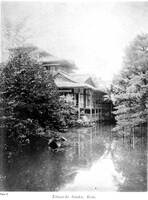The Abbot's palaces belonging to the Shinshu Monto sect of Buddhists have always been remarkable for their princely magnificence. That of the Eastern Hongwanji, in Kioto, presents a good example of the luxury displayed in the buildings and surroundings of these establishments. A suite of gorgeously decorated chambers, painted by some of the best artists of the time, and originally forming part of the Regent Hideyoshi's palace at Fushimi, serve as the Abbot's chief reception rooms. In the grounds adjoining may be seen a three-storied building, somewhat resembling in its outline that of the Kinkakuji, and called the Huin-kaku, or "Pavilion of Fleeting Clouds." This, like parts of the Momoyama Palace, was removed from Fushimi, having been presented to the Hongwanji Temple by the great Taiko-Sama. It is round this quaint villa that is constructed the small garden Tokusui-In, a portion of which is represented in Plate X. A narrow lake encircles two sides of the building, crossed in one place by a fantastic wooden bridge, the floor, parapet, and curved roof of which are all gracefully arched. The belt of water widens out in one place and contains a little island adorned with evergreen bushes and rocks, and connected with the opposite shore by bridges formed of granite monoliths. Portions of the banks are thickly planted with maples, pines, and blossoming trees, shading the water and its moss-covered rocks, and producing a delightfully cool effect. The foreground has garden lanterns, curious rocks, and other characteristics of a Japanese landscape garden.

